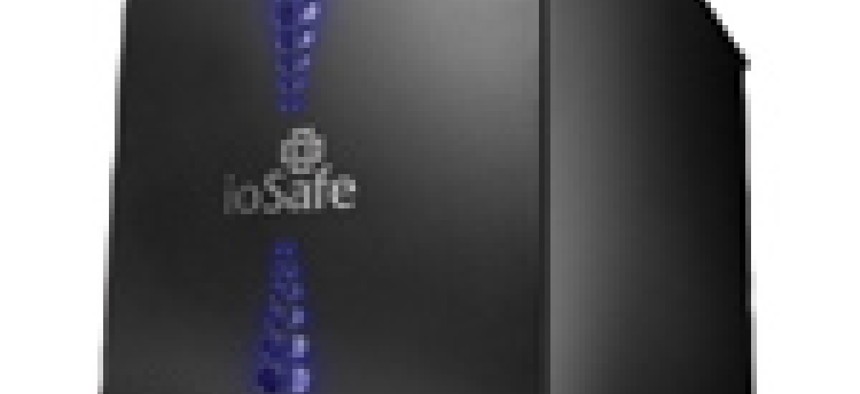With SoloPro, backup data is safe at home


Connecting state and local government leaders
The ioSafe secure drive comes in a solid casing that can protect against fires and floods for on-site backup, and it can transfer data at USB 3.0 speeds, although most administrators will need to use a adapter port for that.
The most important goal of storing data is protecting it from all types of factors, environmental and otherwise, that might destroy it.
Network administrators have used a variety of tricks to ensure that data will be recoverable should a disaster strike, although each method has limitations.
Off-site backup, while incredibly useful toward ensuring recovery, might not be an option for the more sensitive information that your organization might be dealing with.
On-site backup storage could face the same dangers that your primary data storage does. If the entire building floods or gets engulfed in a blazing inferno, your backup data is just as doomed as the original. Or is it?
The SoloPro from ioSafe is designed to avert that type of disaster. The drive comes in a heavy, sturdy metal case that measures 5 inches wide by 7 inches high by 11 inches long, and it weighs a whopping 15 pounds. Its size and weight are necessary to protect what’s inside, and the weight certainly means that no one will unintentionally move it around.
ioSafe SoloPro USB 3.0
Pros: Really fast file transfer speeds.
Cons: USB 3.0 adapter port necessary.
Performance: A
Ease of use: A-
Features: A-
Value: A
Price: $250
To add another level of physical security, there is a tab in the back made of the same material as the rest of the casing, so it is easy to bolt the SoloPro to the floor. There is also a slot for a Kensington lock if you need more security.
The model we tested, SJ1000GB1YR, had a single 1T 3.5-inch Serial Advanced Technology Attachment drive inside. That is large enough to hold hundreds of hours of video or hundreds of thousands of photos, depending on size and quality, of course. That should be more than enough room for your most vital and sensitive files.
We connected the SoloPro to a computer through a USB 3.0 port, and it worked as easily as any other drive. Then we performed file transfer tests, using a folder with 1G of files of varying types and sizes. We measured the upload and download transfer times, averaged the results, and calculated the throughput based on these times.
We achieved a very good speed of 385.32 megabits/sec when transferring to the drive and 355.68 megabits/sec going the other way. We in the Lab are still getting used to the phenomenal speed potential of USB 3.0 compared to its predecessors', and the SoloPro is a fine example of what is possible.
But what set the SoloPro apart from other external hard drives is its ability to store recoverable data even in extreme conditions. First, the case is quite sturdy, and although we didn’t put it through Mil-Std-style drop testing, it withstood our low-level "typical use” punishment without any difficulty.
One of the SoloPro’s greatest strengths is that, when the case is damaged, ioSafe claims that the drive inside will still work or at least be intact enough to recover the data.
The SoloPro is rated by ASTM International, formerly known as the American Society for Testing and Materials, to protect the hard drive from fire as hot as 1,550 degrees Fahrenheit for as long as 30 minutes. For some reason, our publishers would not let us set the building on fire to test this, so we had to take ASTM’s word for it.
The ioSafe company also said the SoloPro could be submerged under 10 feet of water for as long as three days, and the drive inside would still be functional. As you might have guessed, the publishers also wouldn’t let us flood an entire floor of the building, or even let us have a swimming pool — but enough about our troubles.
The point is that, according to ioSafe, the SoloPro can take a whole bunch of punishment, and the data on the drive will still be recoverable. People have even run over it with a tank, and although the case was smashed, the drive was physically intact. Don’t even get me started on our requests for a tank.
The company provides a data recovery service that will get the data off the old drive and ship it back — on a new one if necessary. And, if it can’t do it, it will pay as much as $2,500 for a third-party forensic recovery service to get it done. The version we tested had this service for a year. We imagine that is a sign of ioSafe’s confidence.
The only weak aspect we found in the SoloPro was the very thing that made it so fast for file transfers: its USB 3.0 port. This technology is so cutting edge that new computers from most manufacturers don’t provide such a port standard, and any computer you already have almost certainly didn’t come with one.
So to take advantage of the SoloPro USB 3.0 version, you will need to get an adapter card. That shouldn’t be too big a burden because such adapter cards are not expensive, but we felt it necessary to point that out.
The retail price for the ioSafe SoloPro USB 3.0 (SJ1000GB1YR) is $250, which isn’t too much more than a regular 1T Serial Advanced Technology Attachment drive. And with all the guarantees that back it up, we found it to be a good price. You can even extend the data recovery service to three years for $50 or five years for $100.
We can see this drive filling a vital niche in the data security plan of many network administrators.
ioSafe, www.iosafe.com
NEXT STORY: DISA moves data closer to the front lines





